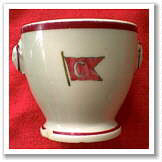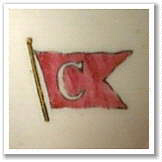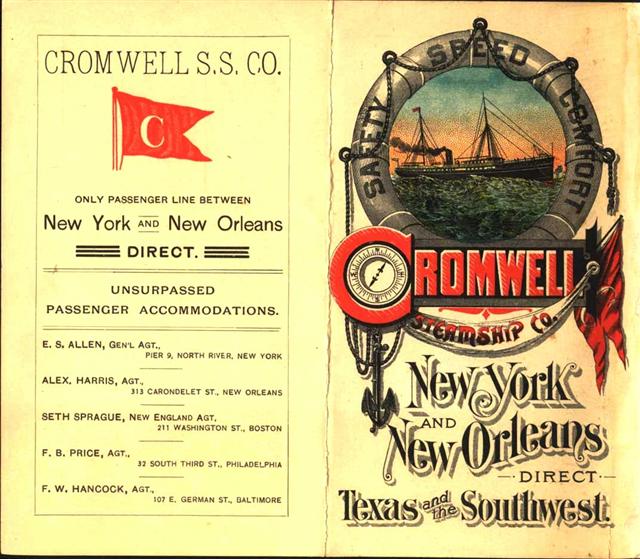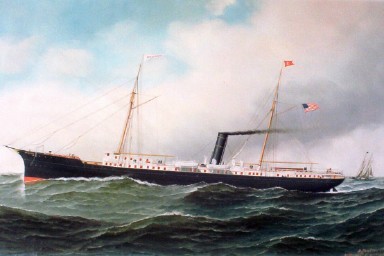  |
  |
Although Mr. Cromwell's commercial interests were so largely connected with the South, it is thought that he firmly upheld the cause of the US government (North) during the war. Henry Cromwell sold nearly all his vessels to the government, and with the additional capital from those sales, immediately proceeded with the construction of two fine new steamers, the George Washington and the George Cromwell. The Line began it's routine New York to New Orleans service with those two new steamers, shortly after the Union's capture of the city of New Orleans in 1862.
During the late 1870's through the 1890s, the Cromwell Steamship Line owned four
first-class steamships, the New Orleans (1872), the
Knickerbocker (1873), the Hudson
(1874), and the Louisiana (1879). With these four luxurious
steamships, the Cromwell Steamship Lines ran steamship passenger service between
New York and New Orleans.
The Cromwell Line was taken over by the Southern Pacific Line in the late 1880s
but continued to operate under the Cromwell Line name and flag until 1902. At that time,
all Southern Pacific properties were consolidated under the flag of the former Morgan Line.
The Cromwell Line Steamship Co. had their offices at the foot of Toulouse St. New Orleans, LA.
and Pier No. 9, North River, New York City. For the City of New Orleans, Cromwell's line of first-class steamships, had the over-whelming confidence
of the public. The Cromwell Line was an excellent example of the kind of company that
influenced much of New Orleans economy following the Civil War and provided many jobs for New Orleans residents.
Other ports touched by the Cromwell Line were Baltimore, Maryland; Savannah, Georgia; Havana,
Cuba; Portland, Maine; Montreal, Quebec, Halifax, and St John's, Canada.
![[Cromwell Line]](uscrmwl.gif)
The Cromwell New York and New Orleans Steamship Line, owned the steamship New Orleans
from 1872 to 1899. Built in 1872, at Pusey & Jones Shipbuilding, the
New Orleans was the first of four new ships built to modernize
the Cromwell Fleet in the early 1870's. In 1899, the Cromwell Line sold the New Orleans, after
over twenty-five years as part of the Line's first-class steamships, to the Merchants and Miners'
Transportation Company for $60,000.
| Vessel | Built | History | |
| Caledonia* | 1853 | Bought in 1854 from Parker Vein Coal Company, sold to US Navy in 1859. | |
| Georges Creek | 1853 | Bought in 1854 from Parker Vein Company, sold at public auction in 1861. | |
| Jackson | 1853 | Bought in 1854 from Parker Vein Company, sold, but still sailing in 1867. | |
| Locust Point | 1853 | Bought in 1854 from Parker Vein Company, sold at public auction in 1861. | |
| Mount Savage* | 1853 | Bought in 1854 from Parker Vein Company, renamed Memphis in 1857, sold to US Navy in 1859. | |
| Parker Vein | 1853 | Bought in 1854 from Parker Vein Company, renamed Atlanta in 1857, sold to US Navy in 1859. | |
| Piedmont | 1853 | Bought in 1854 from Parker Vein Company, possibly renamed in 1858. | |
| Thomas Swan | 1853 | Bought in 1854 from Parker Vein Company, sold at public auction in 1861. | |
| Totten* | 1849 | Bought in 1854 from Parker Vein Company, renamed Chesapeake in 1857, sold to US Navy in 1859. | |
| Westernport | 1853 | Bought in 1854 from Parker Vein Company, sold to US Navy in 1859. | |
| Parkersburg | 1853 | Part of Cromwell Fleet in 1858, formerly named Henry B Beach. | |
| Patapsco | 1853 | Bought in 1854 from Parker Vein Company, sold at public auction in 1861. | |
| Potomac | 1853 | Bought in 1854 from Parker Vein Company, sold at public auction in 1861. | |
| Mount Vernon* | 1846 | Owned by Baltimore Steam Packet Company, renamed USS Mount Washington. | |
| Monticello* | 1859 | Owned by Metropolitan Steamship Co; crushed by ice, Newfoundland, 1872. | |
| Yorktown* | 1828 | Owned by Baltimore Steam Packet Company; 1861 renamed CSS Patrick Henry. | |
| Huntsville* | 1858 | Built for HB Cromwell & Co in 1858, sold to the US Navy in 1861. | |
| Montgomery* | 1858 | Built for HB Cromwell & Co in 1858, sold to the US Navy in 1861. | |
| R R Cuyler* | 1858 | Built for HB Cromwell & Co in 1858, sold to the US Navy in 1861. | |
| Potomski | 1853 | Part of Cromwell Fleet in 1860, sold to the US Navy in 1861. | |
| George Washington* | 1862 | Built for HB Cromwell & Co, struck rocks and sank near Canada in 1877. | |
| George Cromwell* | 1862 | Built for HB Cromwell & Co, lost off Cape St Marys, Canada in 1877. | |
| Republic* | 1863 | Chartered from Merchants Steamship Company for New York to New Orleans in 1866. | |
| Western Metropolis* | 1863 | Chartered from Merchants Steamship Company for New York to New Orleans in 1866. | |
| General Grant* | 1863 | Chartered from Merchants Steamship Company for New York to New Orleans in 1866. | |
| General Meade* | 1861 | Chartered from Merchants Steamship Company for New York to New Orleans in 1866. | |
| Sheridan | 1861 | Chartered from Merchants Steamship Company for New York to New Orleans in 1866. | |
| Crescent City* | 1865 | Chartered by Cromwell Steamship Line in 1866. | |
| Fung Shuey* | 1867 | Bought from Merchants & Miners for the New York and New Orleans Line in 1866. | |
| Mariposa | 1863 | Bought from sheriff for the New York and New Orleans Line in 1866. | |
| Cortes | 1863 | New York and New Orleans Line in 1866. | |
| Claribel | 1863 | New York and New Orleans Line in 1866. | |
| New Orleans* | 1872 | Built for Cromwell Steamship Line, sold to Merchant & Miners' in 1899. | |
| Knickerbocker* | 1873 | Built for Cromwell Steamship Line, taken over by Southern Pacific in 1902. | Hudson* | 1874 | Built for Cromwell Steamship Line, sold to Merchant & Miners' in 1900. |
| Louisiana* | 1879 | Built for Cromwell Steamship Line, taken over by Southern Pacific in 1902. | |
| Canima | 1868 | Chartered by the Cromwell Steamship Line since 1880, sank off Newfoundland in 1883. | |
| Alhambra | 1868 | Chartered by the Cromwell Steamship Line in 1882. | |
| Creole* | 1896 | Built for Cromwell Steamship Line, sold to US Navy in 1898. | |
| General Whitney* | 1896 | Chartered by the Cromwell Line in 1899. | |
| Proteus* | 1900 | Built for Cromwell Steamship Line, taken over by Southern Pacific in 1902. | |
| Comus* | 1900 | Built for Cromwell Steamship Line, taken over by Southern Pacific in 1902. |

